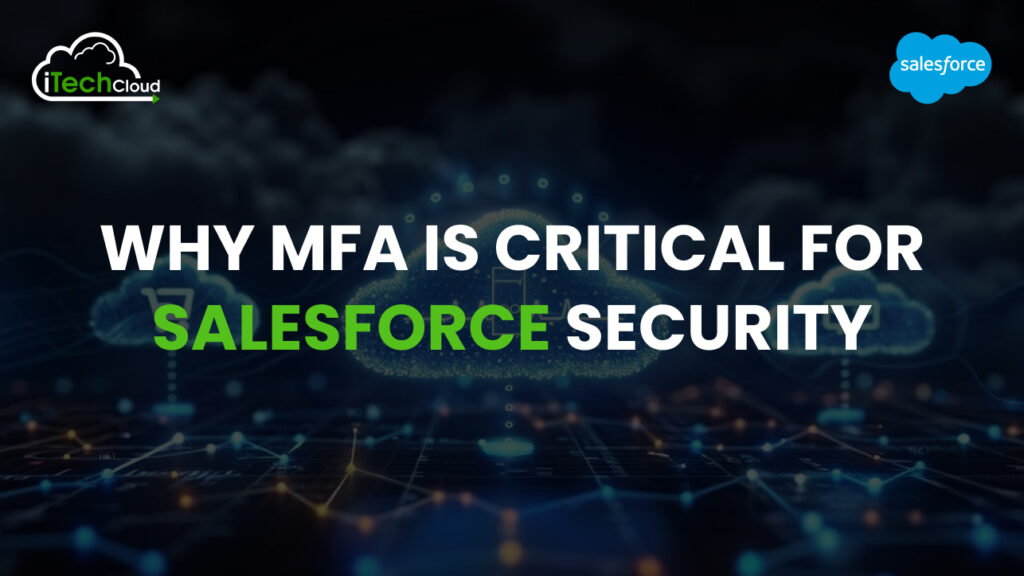Why MFA is Critical for Salesforce Security

In today’s digital age, protecting sensitive data has become a top priority for organizations across the globe. Salesforce, being one of the most widely used CRM platforms, holds vast amounts of sensitive customer information, financial data, and intellectual property. As cyber threats become more sophisticated, safeguarding this data is more challenging than ever. One of the most effective ways to protect Salesforce data from unauthorized access is by implementing Multi-Factor Authentication (MFA).
MFA provides an extra layer of security that goes beyond the traditional username and password. In this blog, we’ll explore why MFA is essential for Salesforce security, how it works, and best practices to ensure its successful implementation.
Table of Contents
Understanding Multi-Factor Authentication (MFA)
Multi-factor authentication (MFA) is a security mechanism that requires users to verify their identity using two or more independent factors before gaining access to an account. These factors fall into three categories:
- Something You Know: This is usually a password or a PIN.
- Something You Have: A physical device such as a mobile phone, security key, or authentication app.
- Something You Are: Biometric authentication such as fingerprint scans, facial recognition, or voice recognition.
MFA adds an additional layer of defense, ensuring that even if an attacker obtains a user’s password, they still need another factor to gain access.
Why Salesforce Requires MFA
1. Protection Against Unauthorized Access
Salesforce houses a treasure trove of customer data, including personally identifiable information (PII), financial data, and confidential business insights. Cybercriminals often target Salesforce accounts to exploit this information. Without MFA, a compromised password can give attackers direct access to the Salesforce environment, leading to data breaches, identity theft, and financial loss.
2. Defense Against Phishing Attacks
Phishing attacks are among the most common methods hackers use to obtain login credentials. Even well-trained employees can sometimes fall victim to phishing emails that appear legitimate. If a user’s credentials are compromised, MFA prevents attackers from gaining unauthorized access.
3. Compliance and Regulatory Requirements
Many industries have strict compliance regulations that mandate strong authentication protocols to protect sensitive data. Regulations such as GDPR, HIPAA, PCI-DSS, and SOX require organizations to implement adequate security measures to safeguard customer information.
4. Safeguarding Against Insider Threats
Insider threats pose a significant risk to organizations, whether from malicious intent or human error. Employees, contractors, or partners with access to Salesforce can unintentionally or intentionally expose sensitive data.
5. Mitigating the Risk of Credential Stuffing
Credential stuffing is a type of cyberattack where hackers use stolen usernames and passwords from one platform to gain access to multiple accounts. Since many users tend to reuse passwords across platforms, this attack can be devastating.
How MFA Works in Salesforce
Salesforce offers multiple ways to implement MFA, ensuring flexibility and ease of use for organizations. Below are the common methods available:
1. Salesforce Authenticator App
The Salesforce Authenticator App is a mobile application that allows users to approve or deny login attempts directly from their smartphones. It supports push notifications, time-based one-time passwords (TOTP), and offline mode, making it a highly secure and convenient option.
2. Third-Party Authentication Apps
Users can also use third-party authentication apps like Google Authenticator, Microsoft Authenticator, or Authy to generate TOTP codes. These apps generate a unique, time-sensitive code that users enter during the login process.
3. Security Keys
Hardware-based security keys, such as YubiKey or Google Titan Security Key, offer another level of protection. These physical devices provide a secure method of authentication and are resistant to phishing attacks.
4. Built-In Biometric Authentication
Salesforce also supports biometric authentication, such as fingerprint and facial recognition, for devices that have this capability. This method is not only secure but also provides a seamless user experience.
Key Benefits of Implementing MFA in Salesforce
1. Security Posture
MFA significantly reduces the likelihood of unauthorized access to Salesforce accounts. Even if attackers obtain user credentials, they will be unable to bypass the additional verification step.
2. Reduced Risk of Data Breaches
Data breaches can have catastrophic consequences for organizations, including financial loss, legal repercussions, and reputational damage. MFA acts as a strong deterrent against such incidents by adding an extra layer of security.
3. Compliance with Security Standards
By implementing MFA, organizations align themselves with industry best practices and comply with regulations such as GDPR, HIPAA, and PCI-DSS, avoiding potential fines and legal consequences.
4. Increased User Confidence and Trust
When users know that their data is protected by strong security measures, they are more likely to trust the platform. This fosters stronger relationships between businesses and their customers.
5. Protection Against Evolving Cyber Threats
Cyber threats are constantly evolving, and traditional security measures are no longer sufficient. MFA is a proactive approach that adapts to emerging threats, ensuring that your Salesforce environment remains secure.
Best Practices for Implementing MFA in Salesforce
1. Educate Users About MFA
User awareness is critical to the successful implementation of MFA. Organizations should educate employees about the importance of MFA, how it works, and how it protects sensitive information.
2. Enforce MFA for All Users
MFA should be enforced for all users with access to Salesforce, including admins, standard users, and external partners. This ensures that no account becomes a vulnerability.
3. Leverage Conditional Access Policies
Conditional access policies allow organizations to define rules that require MFA based on factors such as user location, device type, or risk profile. This approach ensures a balance between security and user convenience.
4. Monitor and Audit User Activity
Regularly monitor user activity and login attempts to detect any suspicious behavior. Salesforce provides detailed logs that help administrators track authentication attempts and identify anomalies.
5. Implement Backup Authentication Methods
To prevent lockouts, provide users with backup authentication methods, such as backup codes or alternate devices, to ensure continued access during emergencies.
Common Challenges and How to Overcome Them
1. User Resistance to MFA
Employees may resist MFA due to perceived inconvenience. To address this, highlight the security benefits and provide user-friendly authentication methods.
2. Device Compatibility Issues
Ensure that MFA methods are compatible with the devices used within the organization. Provide multiple authentication options to accommodate diverse user needs.
3. Forgotten or Lost Devices
To mitigate the risk of lost or forgotten devices, implement backup authentication methods and educate users about the recovery process.
Conclusion:
In an era where data security is paramount, implementing Multi-Factor Authentication (MFA) is no longer optional—it’s a necessity. Salesforce’s mandate to enforce MFA demonstrates its commitment to protecting customer data and ensuring compliance with industry standards.
By adding an additional layer of security beyond traditional passwords, MFA safeguards your organization against unauthorized access, phishing attacks, credential stuffing, and insider threats. Adopting MFA not only strengthens your security posture but also fosters trust among customers and stakeholders.

